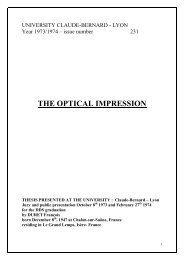english version(pg40to78) - Pr. François Duret
english version(pg40to78) - Pr. François Duret
english version(pg40to78) - Pr. François Duret
You also want an ePaper? Increase the reach of your titles
YUMPU automatically turns print PDFs into web optimized ePapers that Google loves.
F <strong>Duret</strong> and Coll. <strong>Pr</strong>incipes de fonctionnement et applications techniques de l’empreinte optique dans l’exercice de cabinet<br />
(traduction Anglaise)<br />
Page 107<br />
The ideal solution would be that the prosthetic material would be the<br />
same nature as the receiving organ’s tissue, and that the linking agent<br />
would be a real chemical “adherence”, that is to say a molecular link<br />
between the material on the one hand and the enamel and dentin on<br />
the other. Unfortunately, we all know that such a proposition will stay<br />
wishful thinking. However, we concentrate all our research on this<br />
objective.<br />
Given into account the constant precision of CAM, we can insure<br />
interface spaces which can be evaluated to constant 50µm. We<br />
estimate that at this precision level, privileged links can establish<br />
between both present elements.<br />
At this justness degree, let’s say exactitude, we dispose of a solid<br />
discussion basis to evaluate the characteristics of the body which will<br />
be responsible for the links between the prosthetic material and the<br />
receiving organ. We consider that a linking agent must have a very<br />
specific power defined by the nature of present materials and the<br />
geometry of their interface.<br />
To a constant interface value will correspond a “sticking” notion; it is<br />
towards this notion, of course, that our preferences will go, especially<br />
when we know the ionic exchanges and therapeutic possibilities which<br />
come with it.<br />
To an uncertain interface value will correspond a “filling” notion; this<br />
is much less interesting for us and you wouldn’t be surprised to see us<br />
abandon this formula which has for only sense to establish a<br />
relationship between two surfaces whose shape can’t be foreseen.<br />
The receiving organ<br />
This will have for immediate effect the questioning of our<br />
preparations’ shapes. We will in each clinical case analyse, reason to<br />
conceive better the preparation style which will “save” it best.<br />
♦ The receiving organ (dentin and pulp parenchyma)<br />
♦ Associated formations (parondont, endost, ATM)<br />
These talks about the happy consequences of the manufacturing only<br />
constitute here a rough drawing of the dental biomaterial. We will<br />
remember of this short approach the fundamental notion.<br />
Les Cahiers de <strong>Pr</strong>othèse (50) pp 73 – 110, 1985



